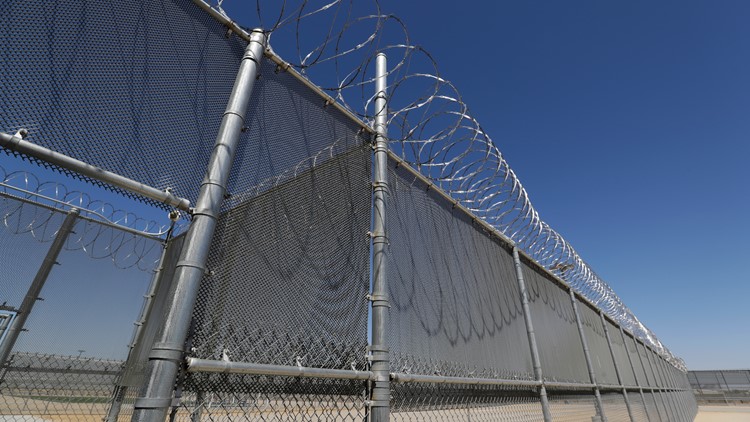CALIFORNIA, USA — Lea este artículo en español.
Who is responsible for vaccinating immigrants in California’s detention centers? Neither state officials nor federal agencies have taken responsibility.
In the midst of this chaos, one county, San Diego, has already taken action and sent doses of the COVID-19 vaccine to a local detention center. But another county, San Bernardino, is awaiting instructions from state health officials on when detainees will become eligible for shots.
Because detainees are in federal custody, state health officials said last week that they aren’t sure who is responsible for vaccination at the detention centers.
“I will tell you very transparently right now, the answer is I don’t know,” California Surgeon General Nadine Burke Harris, who chairs the state’s vaccine advisory committee, told committee members on Wednesday. “There are some real complex jurisdictional issues that are at play.”
That same day, while visiting a vaccination clinic in Riverside County, Gov. Gavin Newsom said detention facilities are “operated uniquely and distinctively from the state.”
So far, 571 people have tested positive for the coronavirus in California’s seven immigration detention centers, including 270 at the Adelanto facility in San Bernardino County. One detainee died of COVID-19 at the Otay Mesa facility in San Diego County, according to ICE’s COVID-19 tracker.
Meanwhile, U.S. Immigration and Customs Enforcement officials say that while its medical staff may help administer the vaccinations, it’s up to states and local health departments to come up with the doses and a plan for vaccinating detainees. Six of California’s seven centers are operated by private companies.
“COVID-19 vaccines for ICE detainees are being allocated by local and state health departments, and were incorporated into the total COVID-19 vaccine amount distributed by the federal government to each state,” an ICE spokesperson said in an emailed statement.
The ICE spokesperson said “a limited number” of detainees have been vaccinated in some states, but this ultimately depends on when local officials send vaccines. The agency did not say where or how many vaccines had been administered to detained immigrants.
California’s detention centers can house about 7,000 people, although attorneys estimate that they are now housing fewer than 2,000. Immigrants are held, sometimes for months, because they do not have proper documentation and are awaiting court proceedings.
Health officials say people living in congregate facilities are at high risk of contracting COVID-19.
Advocates and attorneys for the detainees say they have been seeking answers from the federal government and state even before the vaccine was available. But they still have more questions than answers.
Throughout the pandemic there has been confusion about the role state and local health authorities play within these federal facilities, said Hamid Yazdan Panah, an immigration attorney and advocacy director for Immigrant Defense Advocates.
“A year into this pandemic and we still have so much confusion,” he said. “It boggles my mind that we’re not able to get a decisive (vaccination) plan.”
State legislators, led by Assemblyman Rob Bonta, a Democrat from Oakland, introduced AB 263, a bill that would clarify that state and county health officials have authority to enforce health orders in private detention centers that contract with the federal government.
“Ensuring that health orders are followed in private detention facilities will not only save lives inside these facilities but will also protect public health in the vulnerable communities and rural regions where most of these detention centers are located,” co-author Assemblymember Joaquin Arambula, a Fresno Democrat, said in a press statement.
San Diego’s public health department on Thursday said that it had sent doses to the Otay Mesa Detention Center, where approximately 300 people were in ICE custody as of last month. The county, however, could not say how many people had been immunized and directed questions about vaccine administration back to ICE, which told CalMatters it did not have immediate answers.
Some immigrants at Otay Mesa have started to get shots, but it’s unclear who qualifies and how doses are being divided among detainees and staff, said Monika Langarica, an immigrant rights staff attorney with the American Civil Liberties Union in San Diego.
“What we do know is there are still many medically vulnerable people who want the vaccine who haven’t been vaccinated,” she said.
According to the San Diego public health department, Otay Mesa must follow federal and state guidelines, which means that health staff and detainees 65 and over should be getting their first doses.
Officials in San Bernardino County said they will be sending doses to the Adelanto detention facility, where ICE’s medical staff will administer the shots. But the county is first waiting for the state to outline when detainees will become eligible.
The Adelanto facility, operated by The Geo Group, Inc, isn’t required to provide the health department with numbers on positive cases, deaths or vaccinations, according to the county.
“The county has reached out to the facility on occasion to offer assistance with testing and other COVID-related matters, but all indications have been that they feel they are capable of caring for their people on their own,” a county spokesperson said.
Detention facilities are required to follow state and local health care plans for communicable diseases, according to ICE regulations. But when these facilities don’t follow local guidance, county health officials don’t always intervene, and they may think they don’t have the authority to do so, Yazdan Panah said.
The U.S. Centers for Disease and Control has issued COVID-19 guidance for detention centers, but it also directs facilities to local health departments for further assistance.
On Aug. 24, immigrant rights organizations sent a letter to public health officials in Kern County, home to the Mesa Verde Detention Center, asking about the department’s oversight, including how it planned to ensure detainees were being tested. In a response, the county’s director of public health services said his department does not have jurisdiction over the center.
In the spring, when Otay Mesa, operated by the company CoreCivic, was experiencing an outbreak, San Diego health officials emailed the detention facility recommending mass testing of staff to help mitigate virus spread, according to a copy of the email exchange.
A warden at Otay Mesa responded with: “Doc – Just so we’re clear – at this point we have no intention to mass test our staff,” according to the email.
When asked about detention center vaccinations last week, Newsom sidestepped the question and instead pointed to state prisons and the progress being made there. “I can only talk to you about our responsibility specifically and our stewardship of CDCR,” Newsom said.
The state has given the first dose to almost 40% of its prison population.
CALmatters.org is a nonprofit, nonpartisan media venture explaining California policies and politics



